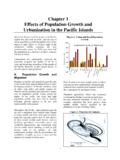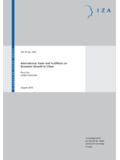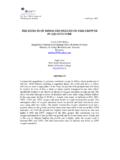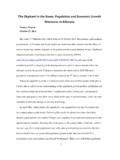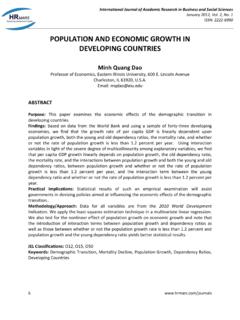Transcription of Population Growth and Economic Development
1 ArticlesPopulation Growthand Economic Development *A discussion of eight major relationshipsthat link demographic patternsand Economic processesBy Samuel H. Preston and Peter DonaldsonSince 1950, Population Growth rates in developing countries have averagedaround 2 per cent per year, enough to double the size of a country s popula-tion in 35 years. The calculation is not merely hypothetical; the populationof the developing world (Africa, Latin America and Asia, except Japan) has infact doubled between 1950, when it numbered billion, and 1984, whenit reached billion.*The authors of this article are Professor Samuel H.
2 Preston of the Population StudiesCenter, University of Pennsylvania, Philadelphia, United States, and Dr. Peter Donald-son, Study Director of the Committee on Population , National Research Council,United States National Academy of Population Journal, Vol. 1, No. 23 Although Population Growth rates have been relatively constant duringthis period (especially if China, with a hilIshaped Growth rate pattern, is ex-cluded from the calculation), the demographic combination through whichthe Growth is achieved has changed birth rates for developing countries as a whole were 45 per thou-sand in the period 1950-1955 but only 31 per thousand in 1980-1985.
3 Thisdecline of 14 per thousand in fertility was nearly matched by a decline of 13per thousand in mortality. The crude death rate was 24 per thousand in 1950-1955 and 11 per thousand in rates of Growth of this size for large aggregates are unprece-dented in human history. Since the 1940s, they have provoked the concernof scientists and policy-makers who felt that prospects for Economic develop-ment in poor countries were being impaired by incessant demographic pres-sures. Many Asian leaders have agreed with this argument. But others haveargued that Population Growth is beneficial for Development , and still others,that Population Growth is largely irrelevant to Economic March 1986, the United States National Academy of Sciences issueda report entitled Population Growth and Economic Development : PolicyQuestions,which reviews these relationships.
4 We decided to frame our report*around a number of specific questions that are enumerated preparation for writing the report, we commissioned 17 backgroundpapers by experts in the field to help assemble the relevant literature and todraw out important points for discussion. Based on these background papers,on a workshop and on independent research, we proceeded to try to answerwhat appear to be the major questions in the of the reportThe report provides no dramatic new analysis of the relationship bet-ween Population Growth and Economic Development . Nor does it provide anunderlying quantitative model that would enable one to determine how muchdifference a decline of, say, 1 per cent in Population Growth rates would make* Other members of the National Academy of Sciences Working Group on PopulationGrowth and Economic Development who helped prepare the report were D.
5 Gale John-son and Ronald D. Lee (co-chairs), Nancy Birdsall, Rodolfo A. Bulatao, Eva Mueller,T. Paul Schultz, Stimrason and Anne D. Williams. Support for the research wasprovided by the United States Agency for International Development , the William andFlora Hewlett Foundation, the Rockefeller Foundation and the National ResearchCouncil Population Journal, Vol. 1, No. 2in various Economic indicators. Instead, it provides a detailed discussion ofeight of the major relationships that link demographic patterns and aspect that distinguishes the report from most earlier assessmentsof those relationships is that it pays more attention to markets and marketconditions as mediating variables.
6 It is also more attentive to conditions in therural sector, where a majority of residents in developing countries continue tolive, and correspondingly to some of the excellent empirical work being doneby agricultural conclusions reached in answering the specific question that wasposed about each of the eight relationships are summarized briefly in this each case, we assume that a country is able to achieve a lower fertility levelby means of a government-sponsored programme, and ask what differencelower fertility would Will slower Population Growth increase the Growth rateof per capita income by increasing the per capita availability of ex-haustible resources?
7 The report s answer is, basically, no . The important exhaustible re-sources are traded on international markets, so this question alone needs tobe answered at the international level. The prices set in those markets reflectthe extraction costs of the resources and their scarcity value while in the Growth , along with income Growth , will probably make these re-sources scarcer, thus driving up their price. This should set off a search forsubstitute materials and for economizing strategies. The dramatic reaction tothe rise in the price of oil induced by the Organization of Petroleum Export-ing Countries (OPEC) is a clear example of those markets at Population Growth probably would delay thetimeat which aparticular stage of resource-depletion or price Increase is reached.
8 But it hasno necessary relationship to the number of people who would live during aparticular stage of resource depletion - we would just get to that stage some-what more slowly. Correspondingly, we would postpone the adaptations re-quired by any stage of resource scarcity. But the problem remains; the pro-blem results from the fixity of nature, and not from the existence of too manypeople. If the human race is to persist, the problem must be dealt this context, the report s approach would be less sanguine if thoseresources were more important, especially in developing countries.
9 But thetotal value of non-fuel mineral resources currently represents only about cent of the total value of world production. With regard to fuel, we areAsia-Pacific Population Journal, Vol. 1, No. 25eventually going to have to rely on sustainable energy sources, especially thesun. This reliance will appear far more practicable when the price of oil andcoal is five or ten times its current Will slower Population Growth increase the Growth rate ofper capita income by increasing per capita availability of renewableresources?The answer to this question is a qualified yes.
10 The report focuses onthe most important of the renewable resources, land. We find evidence thatlarger Population size is generally associated with lower labour productivityin agriculture, the classic situation of diminishing returns. The evidence isdrawn from Bangladesh, northern India, Africa and pre-industrial is not to say that faster Growth does not often set off adaptive res-ponses such as more irrigation and fertilizer use, perhaps more agriculturalresearch and better infrastructure. There is evidence of these responses oc-curring. Japan is a striking 1880, Japan had only 5 per cent as much arable land per worker as theUnited States, but over the next 100 years it registered the same average growthrate of agricultural production as the United States, per cent per report concludes that even after all adaptive responses are factored in -and they are, of course, not costless - labour productivity in agriculture wouldbe expected to be lower when a Population grows is faster Population Growth always or usually necessary to induceadaptive responses.

